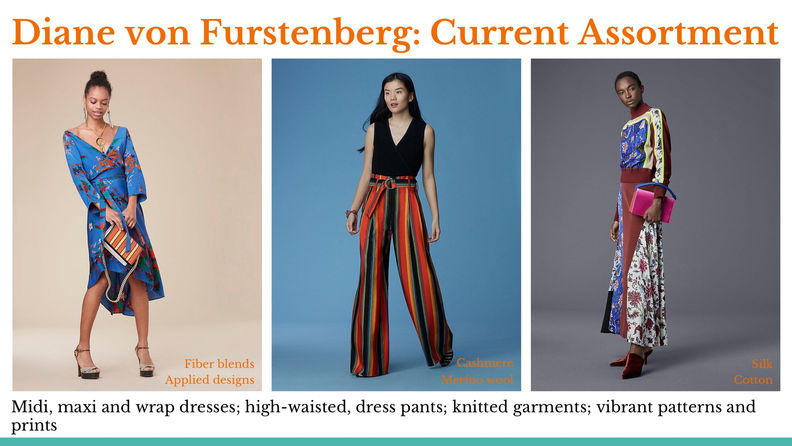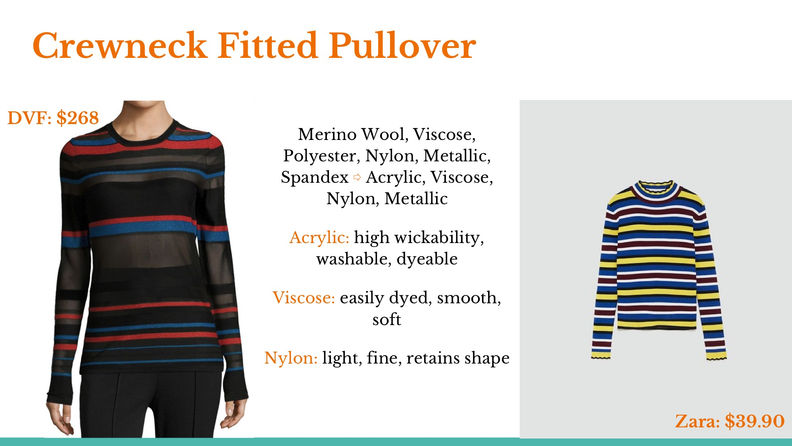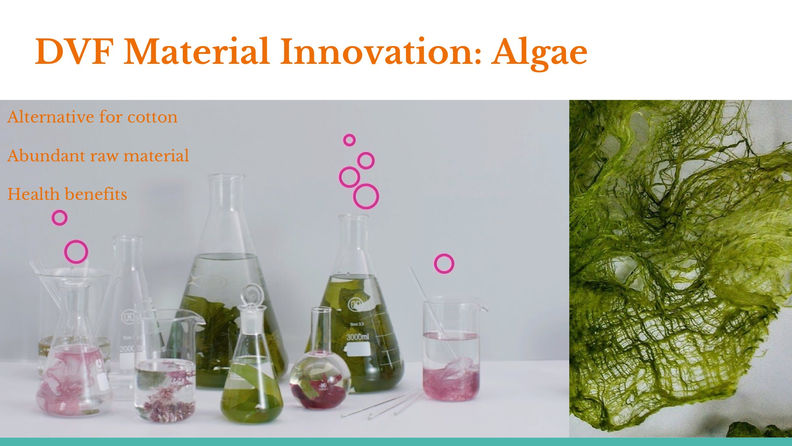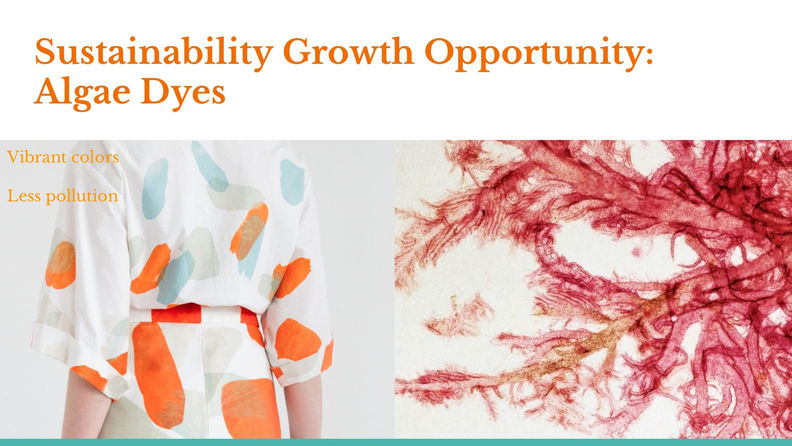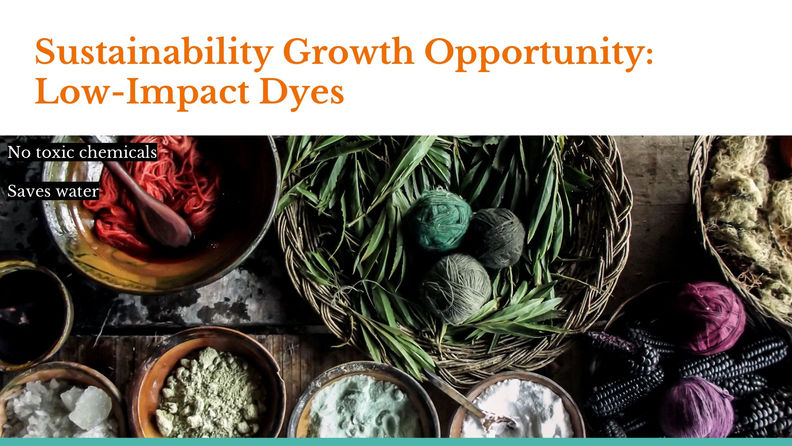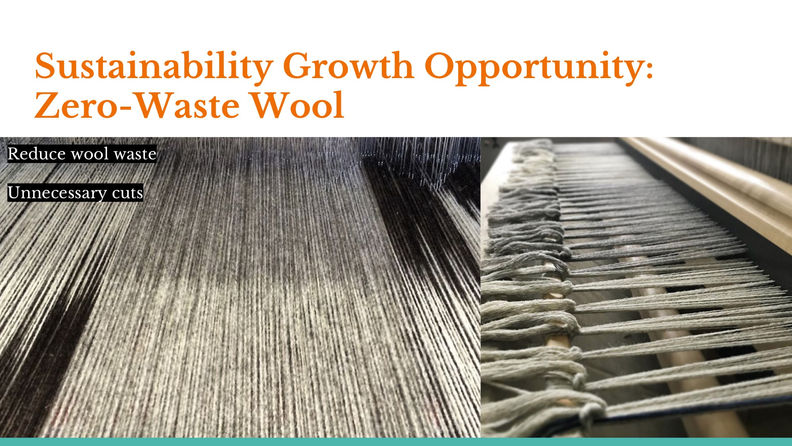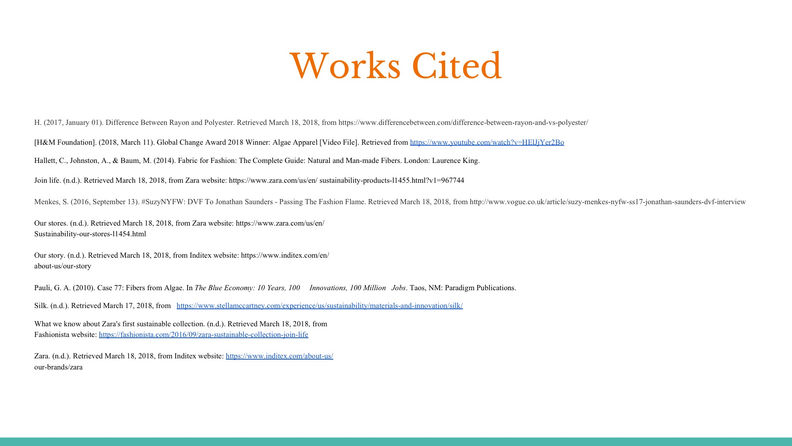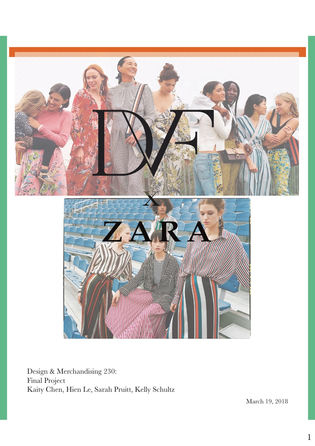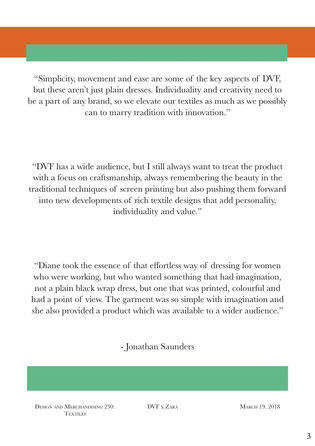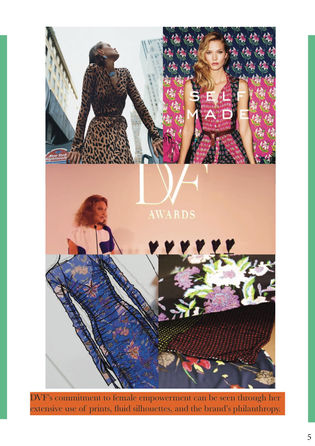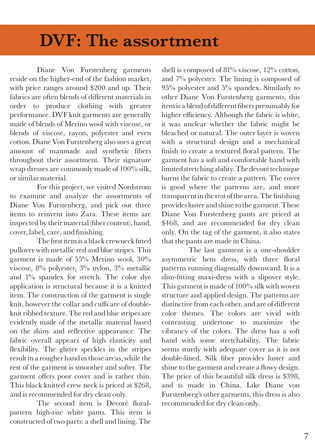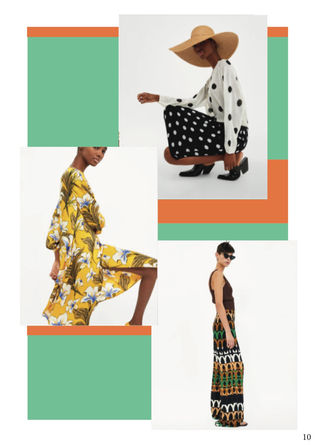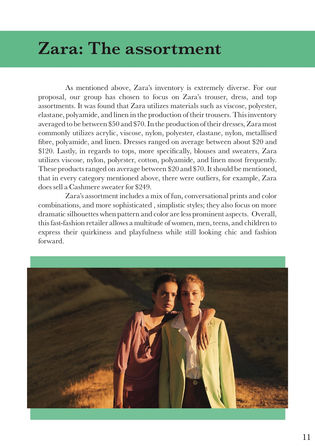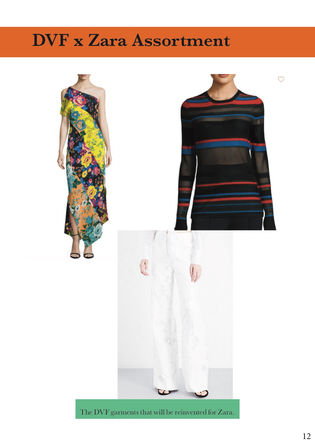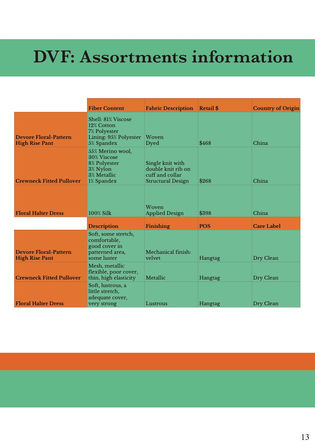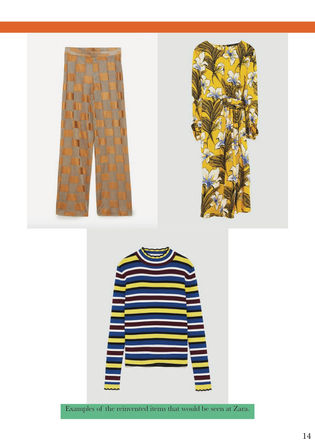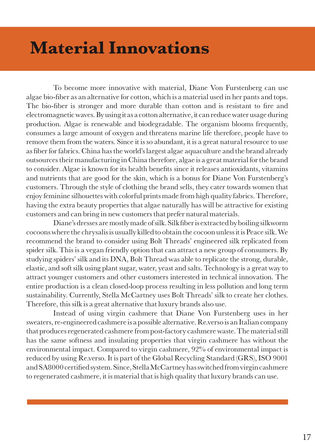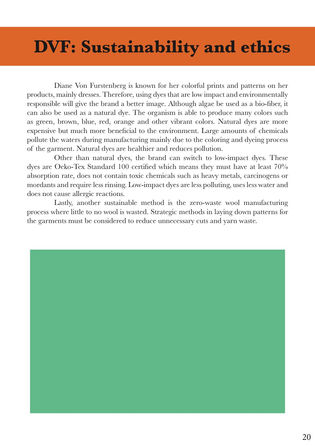

TEXTILES: REFERENCE GuIDE
TABLE OF CONTENTS
1. Overview
2. Fibers
| Animal
| Plants
| Man-made
3. Yarn
4. Structures
| Woven
| Knit
5. Color and Dyeing
6. Printing
7. Finishing
8. Sustainability and Innovation
9. Bringing DVF into ZARA

Overview
Topic Lead Discussion 1: Wool Prices Rise as Sneakers Give Fiber Unexpected Boost
-
Wool prices rising; Adidas is coming up with sneakers that are made of wool
-
Generation Y seems to be more interested in where fabrics come from and how it’s made (eco-friendly)
-
It’s an important issue but its not going to overcome cheaper fabrics → synthetic is easier to produce, cheaper and easier to handle → cutting out whole process of getting wool from animal, treating it etc.
-
trend driven demographic → marketed to younger generation (millennials) and it can become a trend
-
hard to market because wool isn’t exciting and nothing new vs. lululemon with their flashy, sweat proof
-
Activewear → popular market perhaps they can use it with wool
-
Since people are caring more about environment → wool could be making a comeback
-
Lots of pressure on companies having to be more eco friendly, having better processes
-
Would people want to buy wool for quality and higher price or would rather want lower prices synthetic fibers → perhaps company will more likely to blend it to synthetic
-
People don’t really look into quality but rather look into something that looks like wool (fast fashion)
-
Fast fashion also has some eco friendly products → H&M conscious collection → use cheaper quality wool, etc
-
Celebrity endorsement, capsule collection
-
Marketing it to promote eco-friendly like buy this and we will donate to charity → makes people feel better about themselves
-
There has to be a happy medium between quality and price (people aren’t going to buy $10 wool sweater)
Wool Qualities
-
Insulating (seasonless)
-
Moves moisture away
-
The most natural technologically advanced fiber → activewear, outerwear market, suiting
Fibers | Animal



Fibers | Plant
Topic Lead Discussion 2: This Gorgeous, Sustainable “Leather” is Made From Pineapple Waste
-
Pinatex fiber made from discarded pineapple leaves → waste product from fruit industry
-
Good strength, flexibility, long and fine fibers
-
Fake leather uses petroleum → pinatex is better alternative → waste is all used and no fertilizers
-
Decortication → stripping outer layers of leaves → fibers → non woven mesh
-
Issue of supply and demand → harvesting, weather, right now company is sourcing only from Philippines
-
Soft and durable, vegan; leather creates a lot of carbon footprint vs. pinatex created from waste already there
-
Pricing is same as leather
-
Must have good relationship with a good name company → other companies have competition
-
Furnitures, car seats, provide the other option next to leather
-
Also affects meat industry → what happens to the waste skins when everyone goes to alternative





Fibers | Man-Made




Yarn


Structures | Woven
Topic Lead Discussion 5: Maria Sigma
-
Princess trust and virgin start-up scheme funding
-
Hand woven textiles for pillows and upholstery, rugs → zero waste design 100% new british wool, undyed, natural renewable, biodegradable
-
Everything is customizable → high-end
-
Eliminate unnecessary cutting, machinery use, reduce water and carbon footprint
-
Partner with a well known furniture retailer? - high end, collab with small line → get name out and sustainability; partner with interior designers (more personal with companies)
-
More sustainable and less waste for since for home goods → more durable and want it long lasting













Structures | Knit
Topic Lead Discussion 6: Knit Heart Implants by Bolivian Women
-
Single strand of Nitinol metal → lifelong, not as invasive
-
Not mass produced, only making about 300 a month
-
More skilled labor → creating jobs especially for older aged women → bringing more income for family
-
Benefits people in Bolivia because higher altitude, harder to heal → struggle more with heart conditions

Color and Dyeing













Printing


Print Fresh Trip (3/2)
Originals - artist based, 12 designs per week
Cad - get originals ready for production, index and repeat
-
Repeat: Allows design to be printed without any breaks or gaps
-
Uniform and consistent
-
Function of machine limitation - limited pattern capabilities
-
-
Indexing: depending on manufacturing → limited amount of colors depending on machine
-
Digital printing - no color limitation
-
Opportunities for D&M
Curating merchandise and selling to designers
-
No markdown involved, no chargeback, no sales, just selling
Print design - have to merchandise it for designers to buy all 4 prints
Sales team
Vintage - involves buying and sourcing at flea markets

Finishing




Sustainability and Innovation
Topic Lead Discussion 3: East Africa Doesn’t Want Your Hand-Me Downs
-
Ban on import on 2nd hand clothing (Kenya, Rwanda, and few other countries) but they rely heavily on US and European countries for these textiles → goal to have it written by 2020 (Kenya started)
-
Resold in the market or textiles as fabric
-
US and other first world countries intimidated by the move from East Africa since they heavily rely on them
-
70lbs per person waste textile
-
Working with China more than the Western countries cause better relations → teaching workers how to be skilled, boosting industry and creating trade → Western countries threatened → Bold move “enough is enough"
-
We need to start educating ourselves (US) that these landfills of clothing isn’t benefiting Africa → not as a donation but as a market
-
Educating Africans to look for their local industries
-
Teaching them skills of reusing the clothing as textiles for other products (woven rugs, bags, etc.)
-
US once it’s gone we don’t have to think about it again → doesn’t come back to the US
-
Zero waste in the Eastern world vs. Western World (all of animal is used, reusing containers, etc.)
-
Sustainable and ethical fashion is not a trend → we have limited resources
-
LeTote → $59 a month of circulating clothes → people are also concerned about the hygienic aspect → if it is very clean → did they use harsh chemicals to do that?
Topic Lead Discussion 4: Check Me Out: The Library Where You Can Borrow Clothes Instead of Books
-
Lena - borrowing clothes instead of books; in Europe
-
Instead of buying actual garment → subscription money converts to coins → each clothing is amount of coin
-
Want borrowing clothes more normal; reduce waste and recycle clothes
-
Rent the runway; but this company has more vintage clothing
-
Changing the way consumers shops → getting to a habit of recycling clothes
-
flaws/errors → maintaining the subscription; more for customers that are willing to spend for quality pieces; also not wearing it often within a month
-
How are the clothes being taken care of while they are away from company → putting into washer (how are customers keeping it clean and maintaining the quality
-
Subscribers are lazy, often times clothes go missing
-
Improvements - limit the items, the amount of time, charging extra if not returned → awareness to return; minimum subscription length
-
Topic Lead Discussion 7: Sustainable Jeans
-
Most jeans have toxic chemicals and pesticides
-
1 pair = over 900 gallons of water → water is usually sent back into body of water
-
10% of global water pollution comes from textiles
-
-
Reformation's new collection will have least chemicals possible
-
Use left over materials, recycled material, sustainable fabrics
-
88% less water than average, saves 1.8 lb of waste per pair
-
$100-$150
-
New technology for denim product will use 92% less water, 30% less energy = save about 200 mil kilowatt hours of energy, save environmental waste
-
-
They work with recycling facility → customers can choose extra envelope/box donate own old items
-
However that site isn’t obvious or in your face → hard to find
-
-
Eco-friendly is definitely a better and more attractive choice
-
Should be marketed better, or more in your face since cost is #1 thing in consumers mind
-
Hard to see that they are eco-friendly → needs better marketing
-
-
Everlane’s website is great at marketing their eco-friendliness but their brick-and-mortar isn’t great
-
Carbon footprint is released after purchase → dyes are released in the washer
-
Set washer to cold → less energy, prevent 500 lbs of carbon dioxide to be released, better for clothes
-
Little changes can help save water → that water can be used for other uses like droughts, etc.
-
Topic Lead Discussion 8: S.Cafe: Fiber Made of Coffee Grounds
-
Singtex is a Taiwanese company that has found use in these coffee waste after the CEO, Jason Chen saw elder ladies collecting coffee grounds at Starbucks (because of odor elimination property)
-
Only 0.2% of coffee is made from coffee beans the and rest, 99.8% become grounds that are thrown away
-
Coffee grounds are combined with polyester which is made from recycled plastic bottles to make coffee yarn which is then made into fabric
-
The coffee grounds are free from the cafes and stores which helps them reduce carbon footprint
-
One t-shirt is made from 3 cups of coffee grounds and 5 recycled plastic bottles
-
-
Many brands have used his fabrics such as Timberland, American Eagle, Patagonia, Adidas, Oakley, Victoria Secret, North Face
-
Another byproduct of the coffee grounds is coffee oil which the company has used as oil for cosmetics and soaps and can be made into waterproof film and foam pads
-
Jason Chen also is open to spreading his creation globally → Columbia Federation of Coffee Farmers has invited his to help them create textiles using 100% Colombian coffee
Properties of S.Cafe Yarn
-
Naturally eliminates odor
-
Dries fast (200% faster than cotton)
-
Pigment protection
-
Ultraviolet protection
-
Great for waterproof apparel + activewear
-
Fast drying
-
Cool feeling
Questions
-
Since coffee grounds help to eliminate odors, what other potential industries can the fabric be used in?
-
Athletic, footwear
-
-
Why do you think that S.Cafe can be a good alternative to cotton?
-
Require less water
-
-
Do you believe that the fiber has a potential future in the market? Why?
-
Automobile industry since fast drying (stains), towels
-
-
If you were to market the fiber, what factors, qualities or properties would you promote?
Voting to Reinvent Fashion
https://globalchangeaward.com/vote-for-nominee/
I voted for Crop-A-Porter because this idea was the only one that dealt with materials that are already wasted while others dealt with live crops. I like the idea of zero waste. I am also trying to be more conscious of my consumption by considering the product’s end life cycle. Since food and its waste is a big industry, it is a great idea to use it as material because it is already considered waste. Also, instead of relying on natural living material that is unpredictable with weather factors, food waste will always be available.











